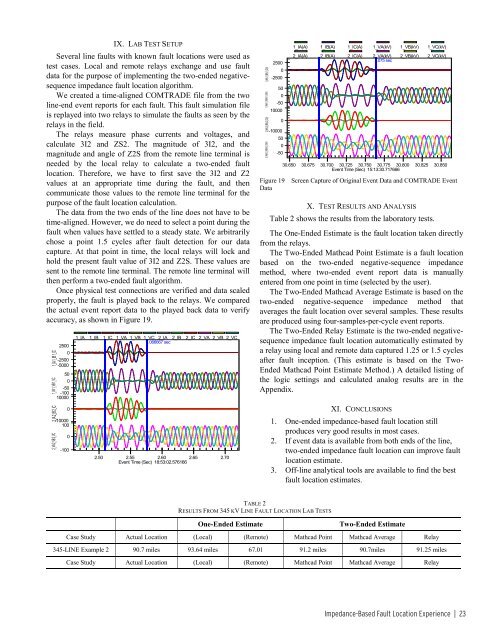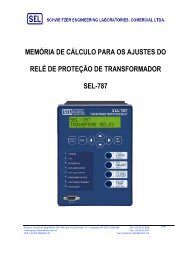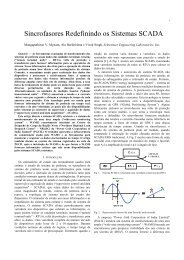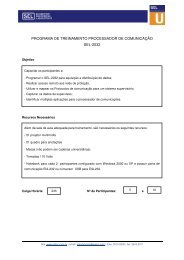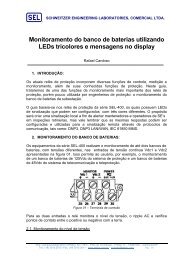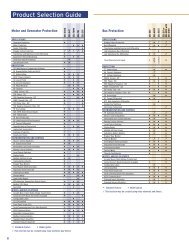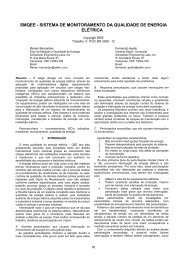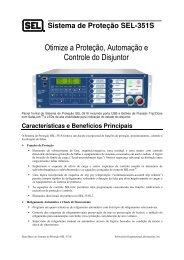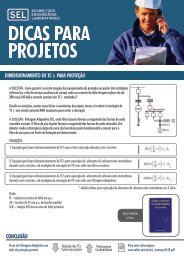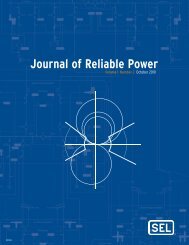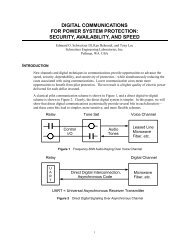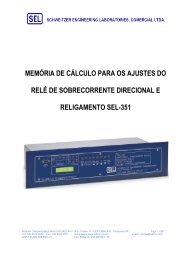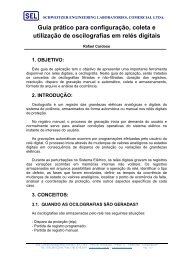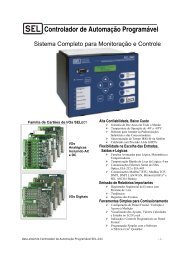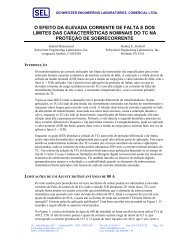Journal of Reliable Power - SEL
Journal of Reliable Power - SEL
Journal of Reliable Power - SEL
You also want an ePaper? Increase the reach of your titles
YUMPU automatically turns print PDFs into web optimized ePapers that Google loves.
IX. LAB TEST SETUP<br />
Several line faults with known fault locations were used as<br />
test cases. Local and remote relays exchange and use fault<br />
data for the purpose <strong>of</strong> implementing the two-ended negativesequence<br />
impedance fault location algorithm.<br />
We created a time-aligned COMTRADE file from the two<br />
line-end event reports for each fault. This fault simulation file<br />
is replayed into two relays to simulate the faults as seen by the<br />
relays in the field.<br />
The relays measure phase currents and voltages, and<br />
calculate 3I2 and ZS2. The magnitude <strong>of</strong> 3I2, and the<br />
magnitude and angle <strong>of</strong> Z2S from the remote line terminal is<br />
needed by the local relay to calculate a two-ended fault<br />
location. Therefore, we have to first save the 3I2 and Z2<br />
values at an appropriate time during the fault, and then<br />
communicate those values to the remote line terminal for the<br />
purpose <strong>of</strong> the fault location calculation.<br />
The data from the two ends <strong>of</strong> the line does not have to be<br />
time-aligned. However, we do need to select a point during the<br />
fault when values have settled to a steady state. We arbitrarily<br />
chose a point 1.5 cycles after fault detection for our data<br />
capture. At that point in time, the local relays will lock and<br />
hold the present fault value <strong>of</strong> 3I2 and Z2S. These values are<br />
sent to the remote line terminal. The remote line terminal will<br />
then perform a two-ended fault algorithm.<br />
Once physical test connections are verified and data scaled<br />
properly, the fault is played back to the relays. We compared<br />
the actual event report data to the played back data to verify<br />
accuracy, as shown in Figure 19.<br />
1_IA 1_IB 1_IC<br />
1_VA 1_VB 1_VC<br />
2500<br />
0<br />
-2500<br />
-5000<br />
50<br />
0<br />
-50<br />
-100<br />
10000<br />
1_IA 1_IB 1_IC 1_VA 1_VB 1_VC 2_IA 2_IB 2_IC 2_VA 2_VB 2_VC<br />
.066667 sec<br />
1_IA(A) 1_IB(A) 1_IC(A)<br />
1_VA(kV) 1_VB(kV) 1_VC(kV)<br />
2_IA(A) 2_IB(A) 2_IC(A)<br />
2_VA(kV) 2_VB(kV) 2_VC(kV)<br />
2500<br />
0<br />
-2500<br />
50<br />
0<br />
-50<br />
10000<br />
0<br />
-10000<br />
50<br />
0<br />
-50<br />
Figure 19<br />
Data<br />
1_IA(A) 1_IB(A) 1_IC(A) 1_VA(kV) 1_VB(kV) 1_VC(kV)<br />
2_IA(A) 2_IB(A) 2_IC(A) 2_VA(kV) 2_VB(kV) 2_VC(kV)<br />
.075 sec<br />
30.650 30.675 30.700 30.725 30.750 30.775 30.800 30.825 30.850<br />
Event Time (Sec) 15:13:30.717666<br />
Screen Capture <strong>of</strong> Original Event Data and COMTRADE Event<br />
X. TEST RESULTS AND ANALYSIS<br />
Table 2 shows the results from the laboratory tests.<br />
The One-Ended Estimate is the fault location taken directly<br />
from the relays.<br />
The Two-Ended Mathcad Point Estimate is a fault location<br />
based on the two-ended negative-sequence impedance<br />
method, where two-ended event report data is manually<br />
entered from one point in time (selected by the user).<br />
The Two-Ended Mathcad Average Estimate is based on the<br />
two-ended negative-sequence impedance method that<br />
averages the fault location over several samples. These results<br />
are produced using four-samples-per-cycle event reports.<br />
The Two-Ended Relay Estimate is the two-ended negativesequence<br />
impedance fault location automatically estimated by<br />
a relay using local and remote data captured 1.25 or 1.5 cycles<br />
after fault inception. (This estimate is based on the Two-<br />
Ended Mathcad Point Estimate Method.) A detailed listing <strong>of</strong><br />
the logic settings and calculated analog results are in the<br />
Appendix.<br />
2_IA 2_IB 2_IC<br />
2_VA 2_VB 2_VC<br />
0<br />
-10000<br />
100<br />
0<br />
-100<br />
2.50 2.55 2.60 2.65 2.70<br />
Event Time (Sec) 18:53:02.576166<br />
XI. CONCLUSIONS<br />
1. One-ended impedance-based fault location still<br />
produces very good results in most cases.<br />
2. If event data is available from both ends <strong>of</strong> the line,<br />
two-ended impedance fault location can improve fault<br />
location estimate.<br />
3. Off-line analytical tools are available to find the best<br />
fault location estimates.<br />
TABLE 2<br />
RESULTS FROM 345 KV LINE FAULT LOCATION LAB TESTS<br />
One-Ended Estimate<br />
Two-Ended Estimate<br />
Case Study Actual Location (Local) (Remote) Mathcad Point Mathcad Average Relay<br />
345-LINE Example 2 90.7 miles 93.64 miles 67.01 91.2 miles 90.7miles 91.25 miles<br />
Case Study Actual Location (Local) (Remote) Mathcad Point Mathcad Average Relay<br />
Impedance-Based Fault Location Experience | 23


